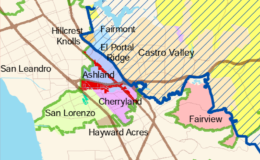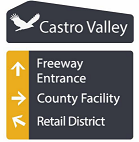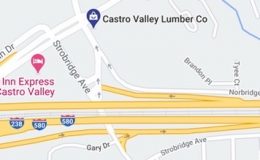I would be interested in a further analysis of the taxes paid. Your arguing if you presume Castro Valley pays 60% of the tax base, then all 60% of the taxes should be re-invested in solely Castro Valley. Although Castro Valley as one single unincorporated area of Alameda Country, (Ashland ¤ Castlewood ¤ Castro Valley ¤ Cherryland ¤ Fairview ¤ Happy Valley
Hillcrest Knolls ¤ San Lorenzo ¤ Sunol) there are many more subsections of Alameda County Unincorporated areas, individually make up equivalents to Castro Valley’s population of an estimated 60,000 residents.
We are all residents of Alameda County, I know these level of infrastructure investments haven’t been made in say Fairview or Cherrryland for a new library and main street improvements. There are ways of estimating taxes paid by the population of each district. Apparently more than everyone else is still not enough regardless of level of need.
Haggerty’s Hyperbolic Castro Valley Math Doesn’t Work
- By : Michael Kusiak
- Category : Alameda County, Economic Development, Governance, Local Control


At the February 2nd Alameda County Board of Supervisors Meeting, Board of Supervisors (BOS) President Scott Haggerty really felt “unloved by the people of Castro Valley.”
A group of local citizens had come to comment on potentially electing the Castro Valley MAC. During the comments, a clearly irritated Haggerty interrupted to say:
“You’re some of the most unappreciative people I’ve ever seen in my life. I mean, I’m not kidding you. Supervisor Valle, myself, Supervisor Carson, we’ve sat to the side when redevelopment was abolished and we gave $90 million back to your community to do projects, like Castro Valley Blvd. and built you a brand new library and you say you want better representation? What the heck is wrong with you people? We’ve been pumping money back into your community for the last few years since Supervisor Miley was elected and you want better representation?”
Haggerty has thrown this $90 Million amount out before in response to Castro Valley public commenters at the BOS as an example of the largesse that the BOS has bestowed upon Castro Valley.
But, is that really true? Is it a fair response to repeatedly throw out at Castro Valley constituents? No, it is not.
Let’s examine the facts.
Redevelopment Recap
Redevelopment agencies throughout the state were dissolved in 2011-12 as a response to California’s budget issues. Since 1945, redevelopment agencies in California were able to create a revenue stream to finance the purchase of properties though the diversion of property taxes in a given “redevelopment area.” The Alameda County Redevelopment Agency (RDA) primarily got its funding from property tax revenues in the Unincorporated Areas of the County. For the 2010-2011 fiscal year budget, the RDA received $18.3 Million in tax revenue from the Unincorporated Areas, with the majority likely coming from Castro Valley tax rolls, being the largest single unincorporated community in the County. Although exact numbers are impossible to get from the County, in the last fiscal analysis done on Castro Valley, it was projected to contribute close to $20 Million in taxes and fees to the county General fund for the fiscal year 2012-13.
After the RDA was dissolved, there were many projects already in the planning and construction phases. In June 2012, at the behest of Supervisor Chan, the BOS agreed to provide funding to complete those planned RDA projects up to $18 Million per year for the next five years, for a total of $90 Million. This was essentially revenue neutral to the County since that money would have been diverted to the RDA anyway if the RDA had not been dissolved.
So, to recap, originally the planned projects were to be funded by $18 Million annually of mainly Castro Valley tax revenue through the RDA, and now they will be completed by that same annual $18 Million of mainly Castro Valley tax revenue directly through the county budget.
The BOS did not give Castro Valley anything that they were not already paying for (through the RDA) with their own taxes.
Now, let’s look at the projects themselves.

This chart lists all of the redevelopment projects in question at the time of the BOS funding. It is broken down into “expended” funding (which was already paid out by the RDA before dissolution), and “new funds” which were to be paid by the new BOS stream of funding. The only Castro Valley project receiving any of the “new” $90 Million is the new shared parking lot project behind the Ice Creamery/Daughtrey’s buildings. The construction on that project has not yet begun. Both of the other fine Castro Valley area RDA projects (the downtown streetscape, and funding for the library) were paid previously by the RDA before they dissolved.
In fact, out of those “new” funds, the largest amount is the $22 Million earmarked for the new Cherryland Community Center — which has also not yet broken ground.
The recently expanded San Lorenzo branch library did receive $9.4 Million out of its $10.3 Million total cost through these “new” funds, but this should not be confused with the Castro Valley library, which was completed in 2008. That $22 Million dollar library was funded primarily by $14 Million from the California Library Bond of 2000, and the rest from the County Redevelopment Agency. An additional $3 Million was raised for technology and furnishings through the Alameda County Library Foundation when the County could not find funding to equip the new branch when it opened in 2008.
One also can’t help but notice that the total cost for all of these Unincorporated Area redevelopment projects is just over $150 Million, and the grand total of all the Castro Valley projects is only $21.2 Million, a mere 14% of the total. It is a fairly safe assumption that tax revenues “pumped in” from Castro Valley made up far more than 14% of that $150 Million, so Castro Valley has a legitimate point about paying for more than they receive from Alameda County.
So, no Supervisor Haggerty, the Board of Supervisors did not “give $90 Million” back to Castro Valley. You have “given back” $3.3 Million of our taxes to build a parking lot.
(Eventually.)


